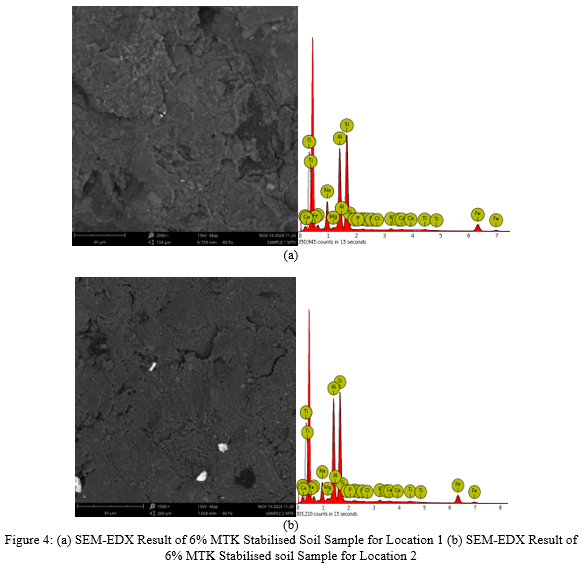Multi-Criteria Evaluation of XL-Terrasil and Metakaolin Geopolymer for Subgrade Improvement in Rural Roads of Ondo State, Nigeria
Keywords:
Lateritic Soils, Metakaolin, XL-Terrasil, Soil Stabilization, Road Construction, Tropical RegionsAbstract
Weak lateritic soils in tropical regions present significant challenges for road construction due to their poor load-bearing capacity and high compressibility. This study evaluated the effectiveness of XL-Terrasoil (XL) and Metakaolin (MTK) in stabilizing weak lateritic soils from three locations in Ondo State, Nigeria, to enhance their suitability for subgrade applications. A laboratory-based experimental approach was adopted. Soil samples were collected from failed road sections and subjected to stabilization, XL -Terrasil and Metakaolin was incorporated into the soil as percentage of its dry weight with dosages set at (0.5%–2.5%) for XL- Terrasil and (2%–10%) for Metakaolin, while the control samples without additive (0% Dosage) was prepared for base line comparison. Tests performed include compaction, unconfined compressive strength (UCS), California Bearing Ratio (CBR), permeability, and microstructural analyses (XRF, SEM-EDX, and XRD). The untreated soil samples exhibited poor engineering properties: Location 1 had UCS of 180 kPa and CBR of 6.5%; Location 2 showed UCS of 165 kPa and CBR of 12%; while Location 3 had UCS of 195 kPa and CBR of 18%. Stabilization with 1% XL improved UCS to 340 kPa (90% increase), while 6% MTK further enhanced UCS to 420 kPa (133% increase). Similarly, soaked CBR improved to 30% with 1% XL and 40% with 6% MTK. Permeability reduced significantly, with 6% MTK decreasing hydraulic conductivity to 8.0 × 10?? m/s (65% reduction). Microstructural analyses confirmed improved bonding between grainsand better crystallinity, silica -alumina promote cohesion and decrease plasticity particularly in MTK-treated samples. The study concluded that Metakaolin outperforms XL-Terrasoil in improving soil strength, durability, and permeability, making it the preferred stabilizer for sustainable subgrade applications in tropical road construction.
Downloads
References
British Standards Institution, “Soils for testing purposes – Methods of test for soils for civil engineering purposes – Part 2: Classification tests,” BS 1377: Part 2, 2019.
British Standards Institution, “Soils for testing purposes – Methods of test for soils for civil engineering purposes – Part 6: Laboratory tests. Section 6.3: Water permeability tests,” BS 1377: Part 6.3.2.6, 2019.
T. Bennich, N. Weitz, and H. Carlsen, “Deciphering the scientific literature on SDG interactions: A review and reading guide,” Science of the Total Environment, vol. 728, p. 138405, 2020.
T. G. L. J. Bikoko and B. N. Bayiha, “Effects of marble addition on the fresh, physical, mechanical, and optical microscopic properties of metakaolin-based geopolymer binders,” Innovative Infrastructure Solutions, vol. 8, no. 1, pp. 1–22, 2023.
M. Hoy, R. Rachan, S. Horpibulsuk, A. Arulrajah, and M. Mirzababaei, “Effect of wetting-drying cycles on compressive strength and microstructure of recycled asphalt pavement-fly ash geopolymer,” Construction and Building Materials, vol. 144, pp. 624–634, 2017.
M. M. A. L. N. Maheepala, M. C. M. Nasvi, D. J. Robert, C. Gunasekara, and L. C. Kurukulasuriya, “Mix design development for geopolymer treated expansive subgrades using artificial neural network,” Computers and Geotechnics, vol. 161, p. 105534, 2023.
N. M. Mashizi, M. H. Bagheripour, M. M. Jafari, and E. Yaghoubi, “Mechanical and microstructural properties of a stabilized sand using geopolymer made of wastes and a natural pozzolan,” Sustainability, vol. 15, no. 4, pp. 1–20, 2023.
A. Mohammad and K. Daniel, “Advances in lateritic soil stabilization for sustainable road infrastructure,” International Journal of Pavement Engineering., vol. 20, no. 5, pp. 567–580, 2019.
S. A. Ola, “The geotechnical properties of the Nigerian lateritic soils,” Engineering Geology, vol. 19, no. 2, pp. 101–110, 1983.
I. Phummiphan, S. Horpibulsuk, T. Phoo-ngernkham, A. Arulrajah, and S. Shen, “Marginal lateritic soil stabilized with calcium carbide residue and fly ash geopolymers as a sustainable pavement base material,” Journal of Materials in Civil Engineering, vol. 29, no. 2, pp. 1–10, 2017.
A. M. S. Pradhan, A. Mukherjee, and D. Sen, “Global climate change and sustainability in civil engineering,” Sustainable Cities and Society, vol. 34, pp. 62–73, 2017.
N. M. Rivera, “Using fly ash to produce alkali-activated cements (AACs) to improve the mechanical performance and durability of stabilized soils for road construction,” Sustainability, vol. 14, no. 11, pp. 1–20, 2020.
R. Sahoo and N. Suresh, “A review on the consolidation and stabilization of lateritic soils using geopolymer technology,” Geotechnical and Geological Engineering, vol. 40, no. 3, pp. 1123–1139, 2022.
S. Turkane and M. Chouksey, “Experimental investigation on stabilization of low-plasticity soil using fly ash geopolymer,” Construction and Building Materials, vol. 235, p. 117576, 2022.
B. A. Wassie, A. W. Mulubrhan, and K. S. Redi, “Sustainable soil stabilization techniques for road construction: A review,” Transportation Geotechnics, vol. 42, p. 100794, 2023.
M. D. Gidigasu, Laterite Soil Engineering: Pedogenesis and Engineering Principles, 1st ed. Amsterdam, Netherlands: Elsevier, 1976.

Downloads
Published
How to Cite
Issue
Section
License
Copyright (c) 2025 Olusumbo Fajemilua, Prof. Olumuyiwa Samson Aderinola

This work is licensed under a Creative Commons Attribution 4.0 International License.
Copyright on any article in the International Journal of Engineering and Applied Physics is retained by the author(s) under the Creative Commons license, which permits unrestricted use, distribution, and reproduction provided the original work is properly cited.
License agreement
Authors grant IJEAP a license to publish the article and identify IJEAP as the original publisher.
Authors also grant any third party the right to use, distribute and reproduce the article in any medium, provided the original work is properly cited.














